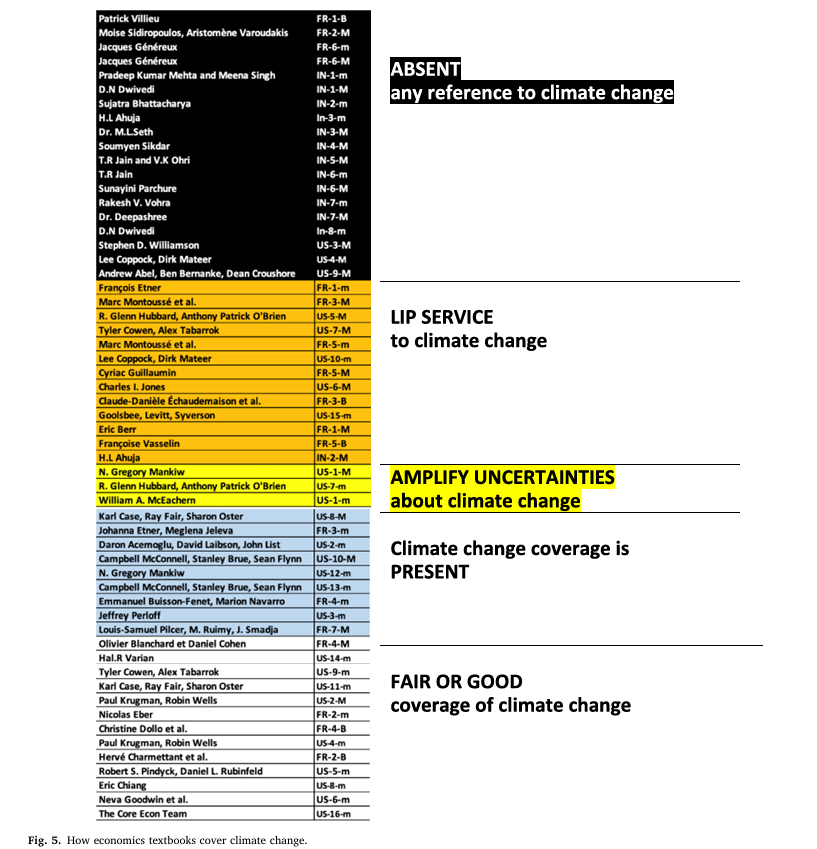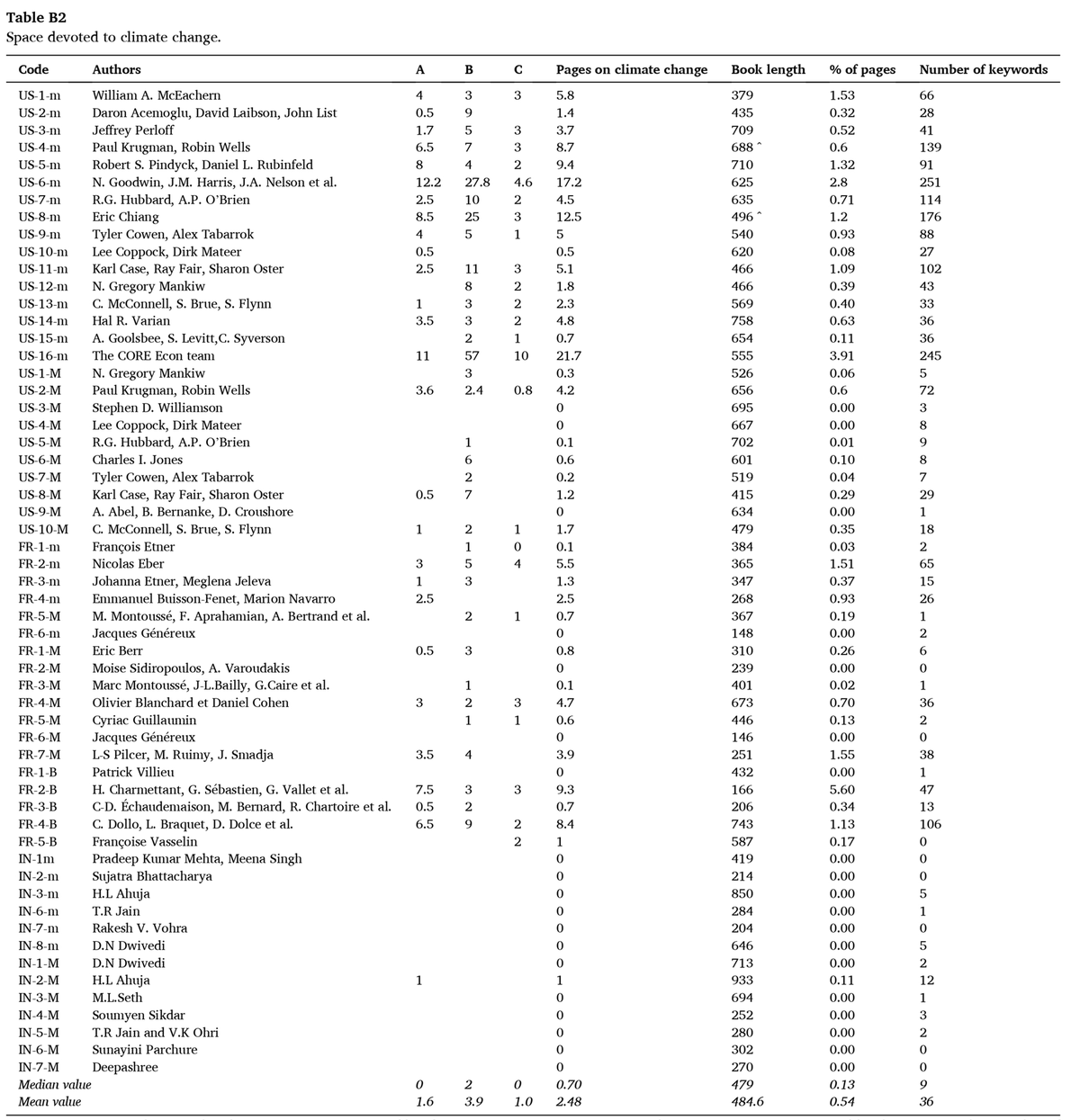- Home
- SUMMARY
- BY TEXTBOOK Apri sottomenù
-
BY TOPIC
Apri sottomenù
- S1 : Greenhouse effect
- S2 : Anthropogenic cause
- S3 : Future scenarios of temperature increases
- S4 : Impacts on Earth’s systems
- S5 : Impacts on economic and social systems
- E1 : Mitigation as a social dilemma
- E2 : Carbon pricing
- E3 : Discounting in reference to climate change
- E4 : Inequality in reference to climate change
- E5 : Social Cost of Carbon and IAMs
- E6 : Persistency & irreversibility in reference to climate change
- E7 : Climate decision-making under uncertainty
- E8 : Climate policies
- E9 : Behavioural issues in reference to climate change
- E10 : Adaptation and geoengineering
- SAMPLE LECTURE
- ABOUT US
SUMMARY
The figure below illustrates the wide variety of approaches to climate change taken in our sample of introductory textbooks. A dividing line that emerges in the profession is between Microeconomics and Macroeconomics, with the latter devoting much less attention to climate change. One unexpected pattern comes from the Indian textbooks, which – with the exception of one author – devote no space at all to climate change. This finding is particularly noteworthy because India is a major polluter and will be hit hard by climate change in the coming decades. Its future ruling class would greatly benefit from having a solid conceptual framework to reason about climate change and evaluate potential solutions but training about this issue will apparently not come from its introductory economics textbooks.
Each book is identified through a code, where: “US” stands for the United States, “FR” for France, and “IN” for India; the last letter is either “M” for Macroeconomics, “m" for Microeconomics, or “B" for coverage of both. N = 57.

METHODOLOGY
The selected textbooks were published or last revised in the years 2015–2024. We measured the space devoted specifically to climate change issues in three different ways: number of pages, keywords count, and position of the material within the book. Regarding the number of pages, we count in absolute terms or as in percentage of all pages in the book, pages that specifically covered climate change either as the main topic, as the application of a general concept, or simply as passing mention.
We also identified the frequency with which seven keywords are mentioned: Climate, Carbon, GHG, Greenhouse, Global warming, Atmospher*, and temperature. Finally, we considered the order of presentation of climate-related material within the book, in terms of median position: a textbook front-loaded with climate change content is different from one that relegates everything to a final chapter or to an appendix with extra material.
More in detail, to calculate the number of pages devoted to climate change we first have identified and sorted the textbook material according to the following three categories depending on how the material has been presented in the textbooks:
A. Parts centering on a climate change issue without linking it to other concepts; usually found when talking about the science of climate change. In addition, parts about using climate-related issues as an illustration of a broader issue; typically, carbon pricing shows up when introducing externalities, or climate mitigation when presenting social dilemmas.
B. A brief passage, usually limited to a keyword or a line, which mostly refers to passing mentions of “climate change” or “global warming”; the simple presence of a keyword would not suffice. In addition, a mention of climate change topics in a section title, in a question or in an exercise at the end of a chapter.
C. A table, box or graph with content about climate change.
The next step has been to calculate a weighted sum of all components, as follows: Number of pages devoted to climate change = A + 0.1*B + 0.5*C.
Each book is identified through a code, where: “US” stands for the United States, “FR” for France, and “IN” for India; the last letter is either “M” for Macroeconomics, “m" for Microeconomics, or “B" for coverage of both.

On average, a textbook devotes 2.68 pages to climate change topics (N = 57). The variability across books, though, is considerable, with a range between 0 and 21.7 pages. We can break down the sample as follows: about 33 % (19/57) devote zero pages, about 25 % (14) one page or less, about 23 % (13) between one and five pages, and 19 % (11) more than five pages.
Given an average book length of 485 pages, the result indicates that in the average textbook, 0.55 % of the material concerns climate issues. Longer books devote slightly more space to climate change, on average.
We also coded where the material related to climate change is located within the textbooks. We find that the median page devoted to climate change issues is on average located in the third quartile (N = 38). More precisely, for 8 % of books the median page is in the first quartile of the volume and for 47 % of them it is in the last quartile.
FOR MORE INFORMATION

This website is based on the research project described in the following journal article: